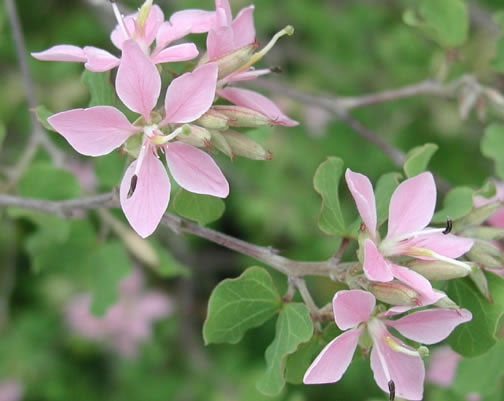Bauhinia lunarioides – Chihuahuan Orchid Tree
Chihuahuan Orchid Tree - A Perfect Fit for Small Spaces
by Greg Starr, Owner Starr Nursery
If you are looking for an unarmed, small tree that can be tucked into a corner of a patio or courtyard or nestled up close to a house without damaging the foundation, investigate using Bauhinia lunarioides the Chihuahuan Orchid Tree. As winter turns to spring, clusters of small, white or rarely pink, orchid-like flowers start to dot this tree with their presence, drawing in swarms of butterflies to sip the sweet nectar. Individual flowers are not long-lived, but there are 6–10 flowers produced, stretching out the flower season for most of spring.
Cultivation
Being native to the dry Chihuahuan Desert, this one is well adapted to the nutrient poor soils of the desert southwest and will grow well without much pampering. The plant is interesting for its small, deciduous, deep green leaves that consist of two, 1-inch long by 1-inch wide leaflets that are shaped like butterfly wings. These small leaflets are but one of many adaptations that allow this tree to survive without much supplemental water. However, if you want your plant to develop into a small tree more quickly, it is best to provide supplemental water on a consistent basis from spring through summer.

Landscape Use
Chihuahuan Orchid Tree is naturally a large shrub that is frequently pruned to become a small multi-trunked tree. It is best to select three main stems to form the structure and remove the rest. Leave some side branches on the main trunks for the first three or four years as they will feed the trunks and help them develop strength and girth. Gradually prune off the lowest side shoots and any extraneous trunks, and over time you will have an attractive small tree that fits into a small patio or courtyard. The plants lack skin-piercing armature making this plant a great choice for places where pedestrians interact. However, the canopy rarely is high enough for people to walk under comfortably and, for that reason, the trees should be kept back from high traffic areas. This tree is also ideally suited for use in smallish planters surrounded by brick or flagstone because the roots are not aggressive and are not liable to wreak havoc or cause heaving of the patio.
For more information on this amazing plant, including the location on the University of Arizona Campus, see the full species description page here
- Log in to post comments



